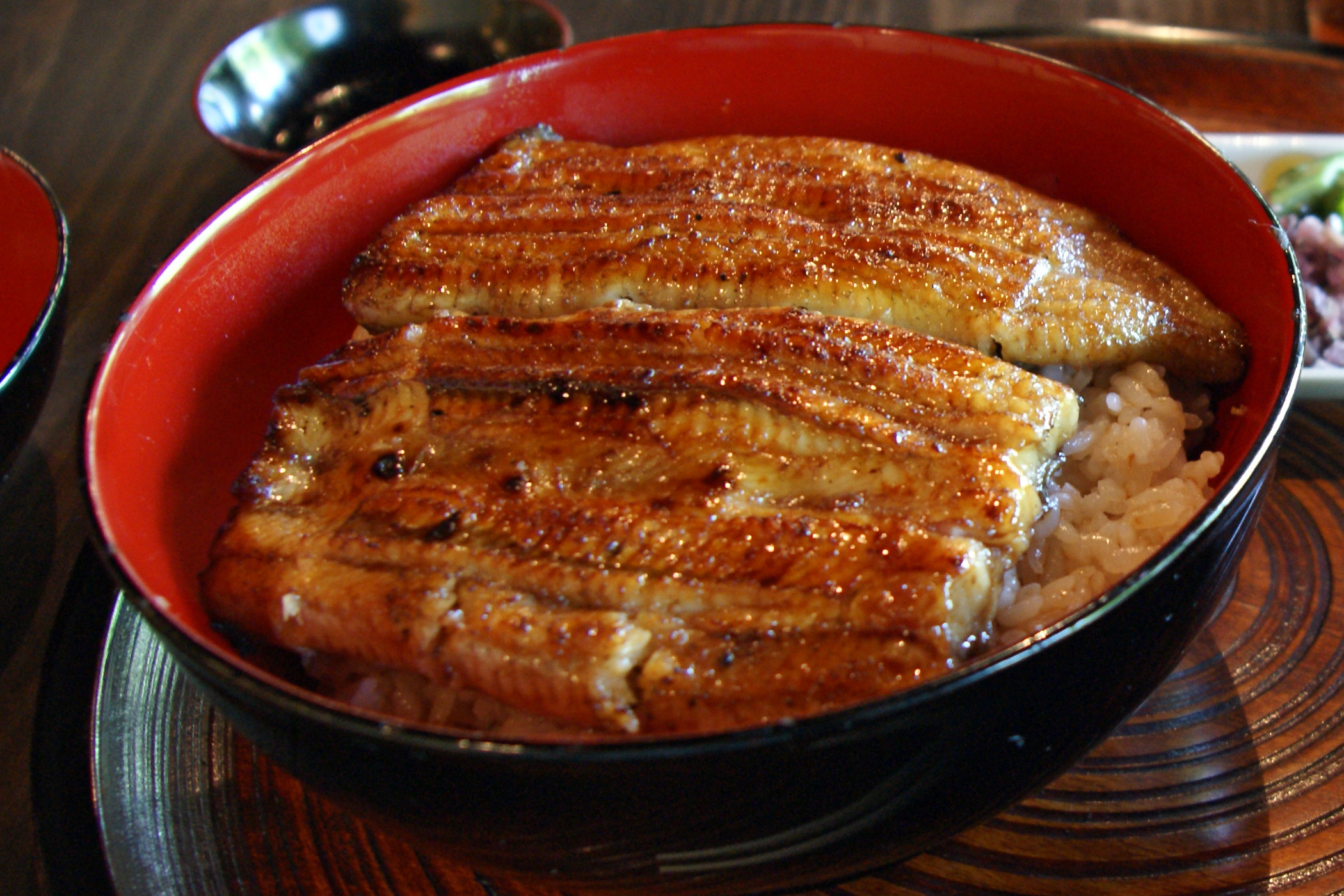Unajuu on:
[Wikipedia]
[Google]
[Amazon]
 is a dish originating in Japan. It consists of a ''
is a dish originating in Japan. It consists of a ''
うな重とうな丼、違いは名前と器だけ
(Excite News, 22 July 2007; author: Wakako Tasachi (田幸和歌子)
 is a dish originating in Japan. It consists of a ''
is a dish originating in Japan. It consists of a ''donburi
is a Japanese "rice-bowl dish" consisting of fish, meat, vegetables or other ingredients simmered together and served over rice. ''Donburi'' meals are usually served in oversized rice bowls which are also called ''donburi''. If one needs to d ...
'' type large bowl filled with steamed white rice, and topped with fillets of eel (''unagi'') grilled in a style known as ''kabayaki'', similar to teriyaki. The fillets are glazed with a sweetened soy-based sauce, called ''tare'' and caramelized, preferably over charcoal fire. The fillets are not flayed, and the grayish skin side is placed faced down., p.63 Sufficient ''tare'' sauce is poured over so that some of it seeps through the rice underneath. By convention, pulverized dried berries of Zanthoxylum piperitum, sanshō (called Japanese pepper, although botanically unrelated) are sprinkled on top as seasoning. It is also very popular outside of Japan, particularly in Taiwan and the Japanese Americans, United States.
Variations
Variations include ''unajū'' (鰻重, the same dish served in ''jūbako'' (重箱), food boxes often lacquered), ''nagayaki'' (長焼き, the eel and rice are served separately), and ''hitsumabushi'' (ひつまぶし). There are two styles of grilled eel, the topic of which is covered more precisely under ''kabayaki''. Essentially, in the Kantō region style, the eel is steamed before being grilled with sauce, which makes the eel more tender. The other is the Kansai region style, which is grilled without steaming.History
Una-don was the first type of ''donburi
is a Japanese "rice-bowl dish" consisting of fish, meat, vegetables or other ingredients simmered together and served over rice. ''Donburi'' meals are usually served in oversized rice bowls which are also called ''donburi''. If one needs to d ...
'' rice dish, invented in the late Edo period, during the Bunka era (1804–1818), section "Una-don, the First Donburi-mono", p.24- by a man named of Sakai-machi (in present-day Nihonbashi Ningyōchō, Chūō, Tokyo), and became a hit in the neighborhood, where the Nakamura-za and Ichimura-za once stood.
The first eatery to sell it as a business is claimed to be ,, p.270, quote;:"鰻丼を始めたのは日本橘葺屋町の大野屋で、天保の飢饉当時に、大丼の鰻飯を天保銭一枚で売ったのが当って" in (adjacent to Sakai-chō) at some indeterminate time, but presumably before the theaters burnt down in 1841 and moved off. After the great famine of 1844, it started selling the ''unadon'' for one oblong Tenpō Tsūhō, Tenpō-sen coin, and became a hit.
As for ''unajū'', where the eel and rice is stuffed in ''jūbako'' boxes, one theory ascribes its originator to one , who started a freshwater fish restaurant business in Sanya, Asakusa, Tokyo, called (later known as Jūbako, the current generation of the restaurant is in Akasaka). According to this version the ''unajū'' was already around by late Edo period, but there are detractors to this view. Other commentators say ''unajū'' appeared in the Taishō era, and by using lacquered boxes, aimed at appearance of luxury. ''Unajū'' is usually pricier than ''unadon''.(Excite News, 22 July 2007; author: Wakako Tasachi (田幸和歌子)
See also
*Katsudon *GyūdonNotes
References
* {{seafood Donburi Japanese rice dishes